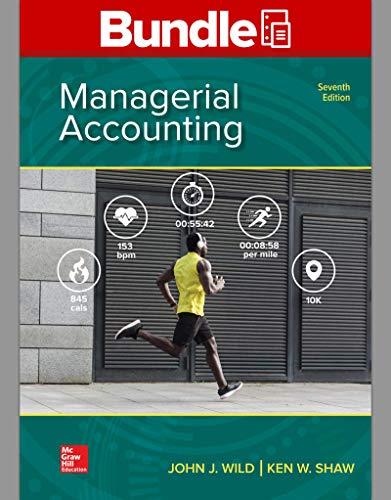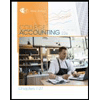
Managerial Accounting + Connect Access Card
7th Edition
ISBN: 9781260581263
Author: John Wild
Publisher: McGraw-Hill College
expand_more
expand_more
format_list_bulleted
Concept explainers
Question
Chapter 13, Problem 7QS
To determine
Concept introduction:
Accounts receivable turnover ratio is a measurement of efficiency of current assets which shows relationship between net sales and average accounts receivable. This ratio tells that how frequently accounts receivables of a company are converted into cash.
Requirement 1:
Accounts receivable turnover.
To determine
Concept introduction:
Accounts receivable turnover:
Accounts receivable turnover ratio is a measurement of efficiency of current assets which shows relationship between net sales and average accounts receivable. This ratio tells that how frequently accounts receivables of a company are converted into cash.
Requirement 2:
Days’ sales uncollected.
Expert Solution & Answer
Want to see the full answer?
Check out a sample textbook solution
Students have asked these similar questions
Can you help me solve this financial accounting question using valid financial accounting techniques?
Rock Industries had sales of $415,000 last year and a net income of $28,245. Its year-end assets totaled $310,000. The firm’s total debt-to-total assets ratio was 40%. Based on the DuPont equation, what was Rock’s Return on Equity (ROE)?
I need guidance in solving this financial accounting problem using standard procedures.
Chapter 13 Solutions
Managerial Accounting + Connect Access Card
Ch. 13 - Prob. 1MCQCh. 13 - Prob. 2MCQCh. 13 - Prob. 3MCQCh. 13 - Prob. 4MCQCh. 13 - Prob. 5MCQCh. 13 - Prob. 1DQCh. 13 - Prob. 2DQCh. 13 - Prob. 3DQCh. 13 - Prob. 4DQCh. 13 - Prob. 5DQ
Ch. 13 - Prob. 6DQCh. 13 - Prob. 7DQCh. 13 - Prob. 8DQCh. 13 - Prob. 9DQCh. 13 - Prob. 10DQCh. 13 - Prob. 11DQCh. 13 - Prob. 12DQCh. 13 - Where on the income statement does a company...Ch. 13 - Prob. 14DQCh. 13 - Prob. 15DQCh. 13 - Samsung Refer to Samsung’s financial statements in...Ch. 13 - Prob. 17DQCh. 13 - Prob. 1QSCh. 13 - Prob. 2QSCh. 13 - Prob. 3QSCh. 13 - Prob. 4QSCh. 13 - Prob. 5QSCh. 13 - Prob. 6QSCh. 13 - Prob. 7QSCh. 13 - Prob. 8QSCh. 13 - Prob. 9QSCh. 13 - Prob. 10QSCh. 13 - Prob. 11QSCh. 13 - Prob. 12QSCh. 13 - Prob. 13QSCh. 13 - Morgan Company and Parker Company are similar...Ch. 13 - Which of the following gains or losses would...Ch. 13 - Prob. 1ECh. 13 - Prob. 2ECh. 13 - Prob. 3ECh. 13 - Prob. 4ECh. 13 - Prob. 5ECh. 13 - Exercise 13-6 Common-size percents P2
Simon...Ch. 13 - Prob. 7ECh. 13 - Exercise 13-8 Liquidity analysis and...Ch. 13 - Exercise 13-9 Risk and Capital structure analysis...Ch. 13 - Exercise 13-10 Efficiency and Profitability...Ch. 13 - Exercise 13-11 profitability analysis P3 Refer to...Ch. 13 - Prob. 12ECh. 13 - Prob. 13ECh. 13 - Prob. 14ECh. 13 - Prob. 15ECh. 13 - Exercise Interpreting financial ratios Refer to...Ch. 13 - Prob. 17ECh. 13 - Prob. 18ECh. 13 - Prob. 1PSACh. 13 - Prob. 2PSACh. 13 - Prob. 3PSACh. 13 - Problem 13-4A Calculation of financial statement...Ch. 13 - Prob. 5PSACh. 13 - Prob. 6PSACh. 13 - Prob. 1PSBCh. 13 - Prob. 2PSBCh. 13 - Prob. 3PSBCh. 13 - Prob. 4PSBCh. 13 - Prob. 5PSBCh. 13 - Problem 13-6BAIncome statement computations and...Ch. 13 - Use the following selected data from Business...Ch. 13 - Use Apple’s financial statements in Appendix A to...Ch. 13 - Prob. 2AACh. 13 - Prob. 3AACh. 13 - Prob. 1BTNCh. 13 - Prob. 2BTNCh. 13 - Prob. 3BTNCh. 13 - Prob. 4BTNCh. 13 - ENTREPRENEURIAL DECISION A1 P1 P2 P3 BTN 13-7...Ch. 13 - Prob. 6BTN
Knowledge Booster
Learn more about
Need a deep-dive on the concept behind this application? Look no further. Learn more about this topic, accounting and related others by exploring similar questions and additional content below.Similar questions
- Can you demonstrate the proper approach for solving this financial accounting question with valid techniques?arrow_forwardWhat is the net operating income for the month under variable costing?arrow_forwardC.S. Cullumber Company had the following transactions involving notes payable. July 1, 2025 Nov. 1, 2025 Dec. 31, 2025 Borrows $37,950 from First National Bank by signing a 9-month, 8% note. Borrows $41,000 from Lyon County State Bank by signing a 3-month, 6% note. Prepares adjusting entries. Feb. 1, 2026 Pays principal and interest to Lyon County State Bank. Apr. 1, 2026 Pays principal and interest to First National Bank. Prepare journal entries for each of the transactions. (List all debit entries before credit entries. Credit account titles are automatically indented when amount is entered. Do not indent manually. If no entry is required, select "No Entry" for the account titles and enter O for the amount in the relevant debit OR credit box. Entering zero in ALL boxes will result in the question being marked incorrect. Record journal entries in the order presented in the problem.)arrow_forward
arrow_back_ios
SEE MORE QUESTIONS
arrow_forward_ios
Recommended textbooks for you
 Managerial Accounting: The Cornerstone of Busines...AccountingISBN:9781337115773Author:Maryanne M. Mowen, Don R. Hansen, Dan L. HeitgerPublisher:Cengage Learning
Managerial Accounting: The Cornerstone of Busines...AccountingISBN:9781337115773Author:Maryanne M. Mowen, Don R. Hansen, Dan L. HeitgerPublisher:Cengage Learning Managerial AccountingAccountingISBN:9781337912020Author:Carl Warren, Ph.d. Cma William B. TaylerPublisher:South-Western College Pub
Managerial AccountingAccountingISBN:9781337912020Author:Carl Warren, Ph.d. Cma William B. TaylerPublisher:South-Western College Pub Cornerstones of Financial AccountingAccountingISBN:9781337690881Author:Jay Rich, Jeff JonesPublisher:Cengage Learning
Cornerstones of Financial AccountingAccountingISBN:9781337690881Author:Jay Rich, Jeff JonesPublisher:Cengage Learning Survey of Accounting (Accounting I)AccountingISBN:9781305961883Author:Carl WarrenPublisher:Cengage Learning
Survey of Accounting (Accounting I)AccountingISBN:9781305961883Author:Carl WarrenPublisher:Cengage Learning Financial Accounting: The Impact on Decision Make...AccountingISBN:9781305654174Author:Gary A. Porter, Curtis L. NortonPublisher:Cengage Learning
Financial Accounting: The Impact on Decision Make...AccountingISBN:9781305654174Author:Gary A. Porter, Curtis L. NortonPublisher:Cengage Learning College Accounting, Chapters 1-27 (New in Account...AccountingISBN:9781305666160Author:James A. Heintz, Robert W. ParryPublisher:Cengage Learning
College Accounting, Chapters 1-27 (New in Account...AccountingISBN:9781305666160Author:James A. Heintz, Robert W. ParryPublisher:Cengage Learning

Managerial Accounting: The Cornerstone of Busines...
Accounting
ISBN:9781337115773
Author:Maryanne M. Mowen, Don R. Hansen, Dan L. Heitger
Publisher:Cengage Learning

Managerial Accounting
Accounting
ISBN:9781337912020
Author:Carl Warren, Ph.d. Cma William B. Tayler
Publisher:South-Western College Pub

Cornerstones of Financial Accounting
Accounting
ISBN:9781337690881
Author:Jay Rich, Jeff Jones
Publisher:Cengage Learning

Survey of Accounting (Accounting I)
Accounting
ISBN:9781305961883
Author:Carl Warren
Publisher:Cengage Learning

Financial Accounting: The Impact on Decision Make...
Accounting
ISBN:9781305654174
Author:Gary A. Porter, Curtis L. Norton
Publisher:Cengage Learning

College Accounting, Chapters 1-27 (New in Account...
Accounting
ISBN:9781305666160
Author:James A. Heintz, Robert W. Parry
Publisher:Cengage Learning
Accounts Receivable and Accounts Payable; Author: The Finance Storyteller;https://www.youtube.com/watch?v=x_aUWbQa878;License: Standard Youtube License